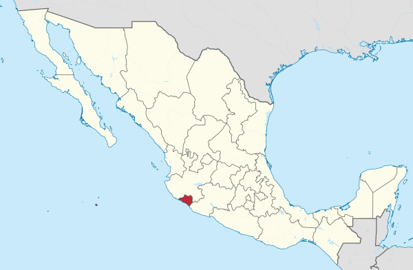Colima State

The state has a high level of socioeconomic development, with one of the highest standards of living in Mexico. Agriculture, forestry and fishing employ 1.2% of the state's population and contribute 8.45% to its GDP. Colima produces about half of Mexico's lime crop, and is second in the production of coconut meat and tuna. Most of Colima's agriculture is based on perennial plants, such as fruit trees, producing limes, coconuts, mangos and bananas, accounting for ninety percent of the volume of agricultural production and 79% of its value. Colima is the primary producer of limes in Mexico. Other important crops include corn, rice, melons, sorghum, chili peppers, coffee, tomatoes and tomatillos.
By volume the most important livestock is that of cattle, followed by domestic fowl, then honey and beeswax. Most livestock production is in the north of the state due to climate, and also includes pigs, goats and sheep. Commercially productive forest stands at about 108,225 hectares with about sixty percent of the trees salable. These forests are mostly rainforest, with some areas of holm oak. Lumber harvesting has decreased in the state owing to conservation measures.
Fishing is concentrated on the coastline in ocean waters of about 641 km2 as well as in 8,350 hectares of lagoons and 2,032 inland bodies of waters. There are also about 3,000 hectares dedicated to fish farming.
Principle catches include tuna and squid, other commercial species include huachinangos, red porgy, combers, wahoo, and mojarra. Fish farming mostly concerns raising shrimp along lakes and lagoons, with an annual production of about 5,000 tons. Some oyster raising takes place as well. The fishing industry in the state supports a canning industry mostly for tuna, shrimp and octopus along with the freezing of fish filets.
Mining is next in importance, with production of iron, mostly from the Peña Colorada, the largest deposit in the country. Manufacturing contributes 4.7% of the state's GDP with 2,007 units of production. Most facilities produce beverages, metal structures, canned foods, cereals, furniture, printed materials, building supplies and dairy products.
Handcrafts in the state are mostly produced for local needs rather than the tourist market. One distinguished craft is the making of palm frond hats, including a local style called the colimote. Ixtlahuacán is noted for its production of hammocks. Other items include huarache sandals, boots, bird cages, cold cuts and costumes and masks for traditional dance.
Much of the state's tourism centers on its beaches in Manzanillo, and in the municipalities of Armería and Tecomán. Manzanillo is the most popular in the state, and a major tourism destination for Mexico's Pacific coast. For this reason, it has developed infrastructure with hotels, restaurants, golf courses, and other attractions.
GDP COLIMA $7,466 million of USD






